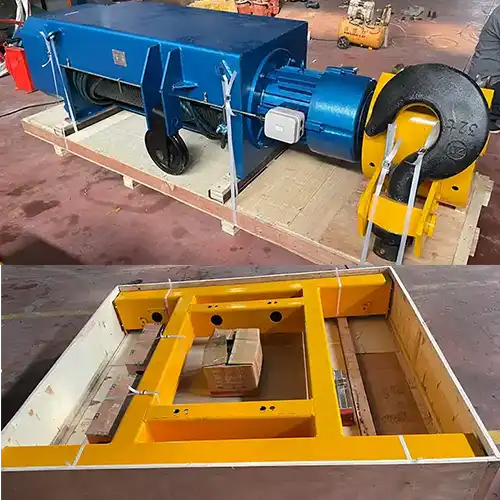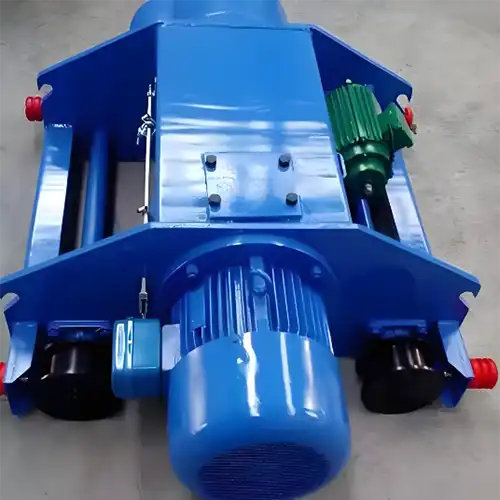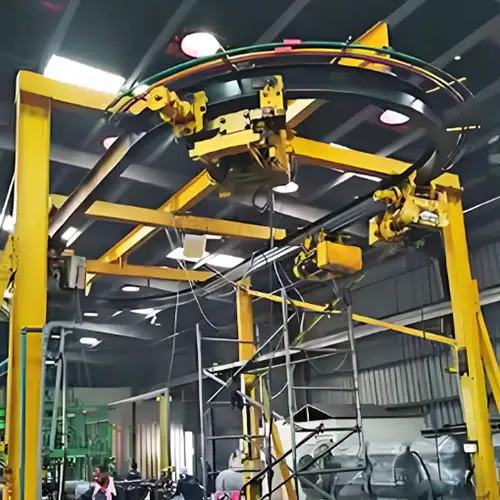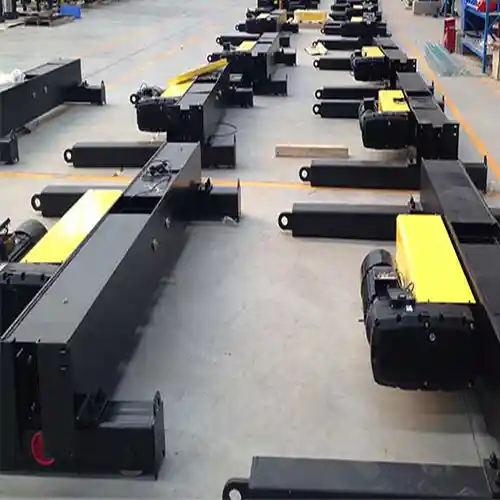Outdoor Electric Hoists for Sale, Chain Hoist & Wire Rope Hoists
Outdoor electric hoists for sale, good price. Outdoor electric chain hoists & outdoor electric wire rope hoists for outdoor overhead crane, gantry crane & jib hoists
Category: Overhead Hoist
Your Trusted Outdoor Electric Hoists Manufacturer & Supplier
Outdoor Electric Hoists for Sale, Chain Hoist & Wire Rope Hoists
Outdoor electric hoists for sale, good price. Outdoor electric chain hoists & outdoor electric wire rope hoists for outdoor overhead crane, outdoor gantry crane & outdoor jib hoist.
Outdoor Electric Hoists: A Comprehensive Guide
When it comes to outdoor tasks requiring heavy lifting or material handling, having the right equipment is crucial for efficiency, safety, and productivity. This is where outdoor electric hoists come into play. These powerful tools are designed specifically to handle various loads in outdoor environments, offering reliability and convenience in challenging conditions.
Outdoor electric hoists are robust lifting devices powered by electricity, utilized for raising, lowering, or horizontally moving heavy objects or materials. They are engineered to withstand the rigors of outdoor settings, enduring exposure to weather elements, dust, moisture, and sometimes extreme temperatures. These hoists commonly include outdoor chain hoists and electric winches, each serving distinct purposes based on their design and features.
Selecting the appropriate outdoor electric hoist is paramount for several reasons. Firstly, these hoists are specifically crafted to endure the challenges posed by outdoor environments. Choosing the wrong hoist that lacks weatherproofing or environmental resistance can lead to premature damage, safety hazards, and operational inefficiencies.
Moreover, the correct hoist selection ensures optimal performance and longevity. Different outdoor tasks demand varying load capacities, power sources, and safety features. Thus, understanding the specific requirements of outdoor applications is crucial in determining the right hoist to maximize efficiency and durability.
Different Types of Hoists for Outdoor Use
Outdoor chain hoists are robust, durable, and commonly used in outdoor settings. These hoists employ a chain mechanism for lifting heavy loads vertically. They are adept at handling diverse load capacities and often come with features such as weather-resistant coatings and sealed components, ensuring reliable performance even in adverse outdoor conditions.
The chain hoists are valued for their simplicity, reliability, and ability to withstand harsh environments, making them an ideal choice for construction sites, warehouses, and outdoor industrial operations.
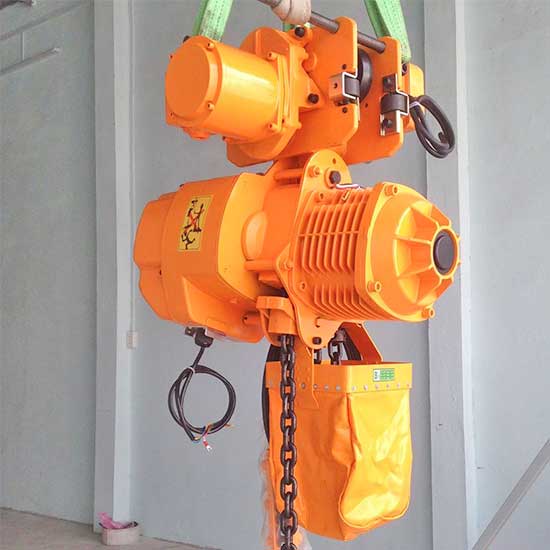
Features:
- Chain Mechanism: Operates using a chain for lifting heavy loads vertically.
- Robust Construction: Durable build suitable for outdoor environments.
- Weather Resistance: Often equipped with weather-resistant coatings for protection.
Benefits:
- Versatility: Suitable for various industries and outdoor applications.
- Durability: Resistant to environmental factors like moisture, dust, and temperature changes.
- Strength: Capable of handling substantial load capacities.
Typical Applications:
- Construction Sites: Lifting building materials, equipment, and machinery.
- Manufacturing: Material handling within manufacturing plants.
- Industrial Operations: Heavy lifting in warehouses and industrial settings.

Features:
- Wire Rope and Drum: Uses a wire rope wound around a drum for lifting.
- High Load Capacity: Capable of handling heavier loads compared to chain hoists.
- Corrosion Resistance: Components may be designed to resist corrosion.
Benefits:
- Strength and Reliability: Suited for heavy-duty lifting applications.
- Adaptability: Versatile and suitable for various industries.
- Longer Lifespan: Components designed for durability and longevity.
Typical Applications:
- Construction: Lifting steel, concrete, and heavy building materials.
- Mining Operations: Handling equipment and materials in mining environments.
- Material Handling: Suitable for heavy loads in manufacturing and logistics.
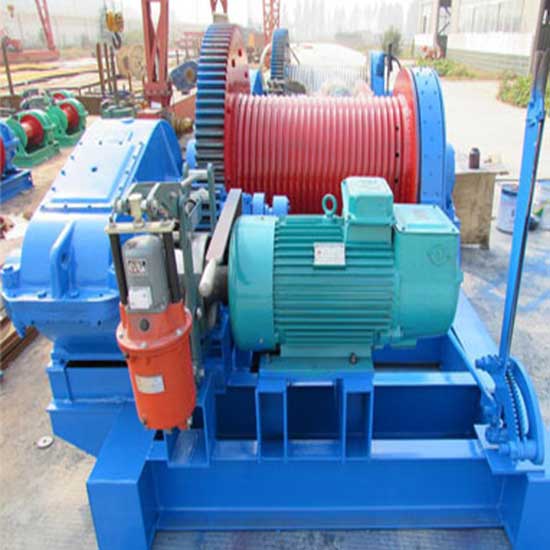
Features:
- Drum and Cable/Rope: A motor-powered drum with a cable or rope for horizontal pulling.
- Remote Operation: Some models come with remote control functionality.
- Weatherproofing: Enclosures designed to withstand outdoor conditions.
Benefits:
- Pulling Power: Ideal for horizontal pulling or towing applications.
- Versatility: Used in off-road vehicles, trailers, and boats.
- Ease of Use: Enables controlled pulling of heavy objects.
Typical Applications:
- Off-Road Vehicles: Recovery and towing in off-road adventures.
- Trailers and Boats: Pulling heavy objects in recreational and industrial settings.
- Construction and Landscaping: Assisting in moving heavy equipment or materials.
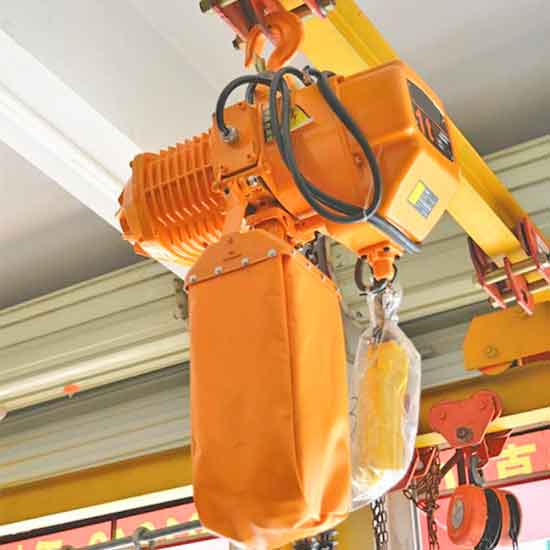
Portable Electric Hoists:
Features:
- Lightweight Design: Easily transportable for use in different outdoor locations.
- Compact Size: Space-saving and convenient for intermittent lifting tasks.
- Simple Operation: User-friendly design for ease of use.
Benefits:
- Mobility: Allows lifting tasks at various outdoor sites.
- Versatility: Suitable for intermittent or occasional lifting needs.
- Convenience: Easy to set up and operate.
Typical Applications:
- Temporary Construction Sites: Lifting and moving equipment or materials.
- Outdoor Events: Hoisting equipment or banners for temporary setups.
- Maintenance Tasks: Portable lifting for occasional maintenance needs.
Each type of outdoor electric hoist offers unique features tailored to specific applications and environments. Understanding the distinct characteristics and benefits of these hoists helps in selecting the most suitable one for particular outdoor tasks, ensuring efficiency, safety, and reliability in lifting operations.
Advantages and Applications of Outdoor Electric Hoists
Outdoor electric hoists, in general, present several advantages over manual or non-electric alternatives. Their key benefits include:
- Enhanced Efficiency: Electric hoists significantly reduce manual labor, increasing work efficiency and productivity.
- Precise Control: They offer precise lifting, lowering, and positioning control, ensuring accuracy in handling heavy loads.
- Safety Features: Many electric hoists come equipped with safety mechanisms like overload protection and emergency stop functions.
- Adaptability: These hoists can handle a wide range of load capacities and are adaptable to various outdoor applications.
Outdoor electric hoists find applications in industries such as construction, mining, agriculture, and logistics, where heavy lifting or material movement is a routine requirement.
Outdoor electric hoists come in various types, each designed to fulfill specific lifting and pulling requirements in outdoor settings. The main types of outdoor electric hoists can be categorized based on their functionalities and mechanisms. Here are the primary types:
- Outdoor Chain Hoists: These hoists operate using a chain mechanism for lifting heavy loads vertically. They are durable, versatile, and often come equipped with weather-resistant coatings, making them suitable for outdoor applications. Outdoor chain hoists are commonly used in construction, manufacturing, and industrial settings where robust lifting capabilities are required.
- Electric Wire Rope Hoists: Electric wire rope hoists utilize a wire rope wound around a drum to lift and lower loads. They are known for their strength, reliability, and ability to handle heavier loads compared to chain hoists. Some models are designed for outdoor use, featuring weatherproof enclosures and corrosion-resistant components. These hoists find applications in industries such as construction, mining, and material handling.
- Electric Winches: Electric winches are specialized hoisting devices primarily used for horizontal pulling or towing applications. They typically consist of a motor-powered drum around which a cable or rope is wound. Electric winches are commonly employed in off-road vehicles, trailers, boats, and other recreational or industrial settings where pulling power is necessary.
- Outdoor Electric Trolley Hoists: Trolley hoists are equipped with a trolley mechanism that allows horizontal movement along a beam or track. They provide flexibility in positioning loads and are used in outdoor settings where material handling requires lateral movement.
- Portable Electric Hoists: These hoists are designed for mobility and versatility. They are lightweight and can be easily transported to different outdoor locations. Portable electric hoists are favored for their ease of use and are suitable for applications requiring intermittent lifting or where a fixed hoist may not be practical.
Each type of outdoor electric hoist offers distinct features and capabilities tailored to specific outdoor applications. The choice among these types depends on factors such as load capacity, environmental conditions, mobility requirements, and the nature of the outdoor task at hand. Buyers and users should carefully assess their needs to select the most suitable type of outdoor electric hoist for their intended application.
Cutomized Types of Outdoor Electric Hoists:
Specialized outdoor electric hoists are designed to meet specific requirements in various industrial sectors. Here are some special types of outdoor electric hoists used in different industries:
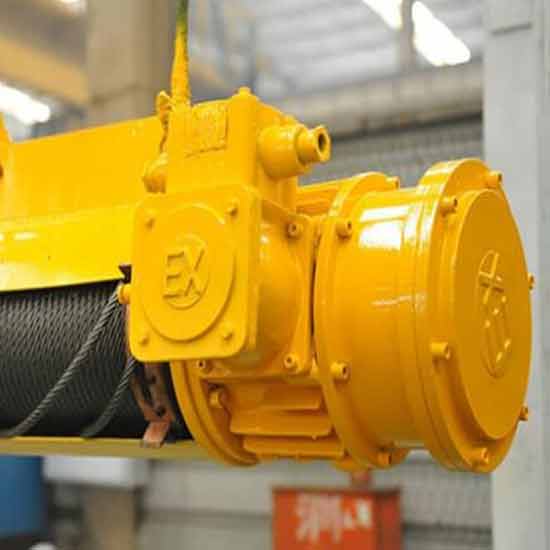
Explosion-Proof Electric Hoists:
Industry Application: Mining, Oil & Gas, Chemical Processing.
Features:
Designed for operation in potentially explosive environments.
Robust construction to withstand harsh conditions.
Enhanced safety measures to prevent ignition sources.
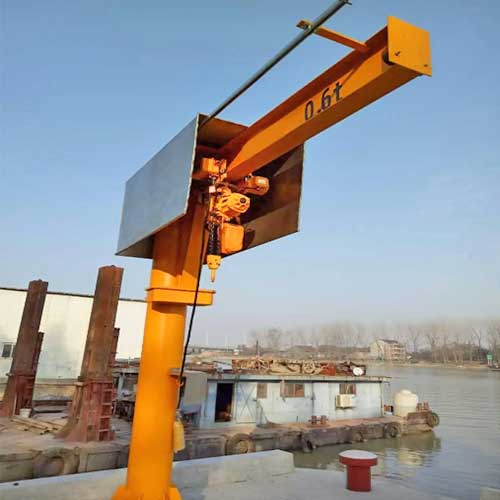
Marine Electric Hoists:
Industry Application: Outdoor jib crane for Shipping, Ports, Offshore Operations.
Features:
Corrosion-resistant materials for use in marine environments.
Weatherproofing to withstand exposure to saltwater and harsh weather conditions.
Specialized attachments for handling cargo and containers.
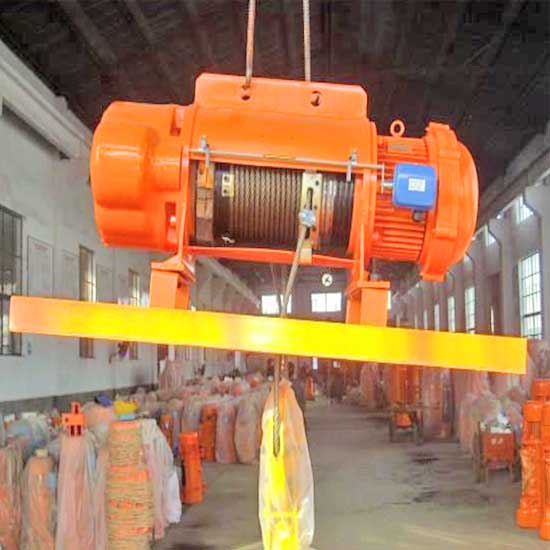
High-Temperature Electric Hoists:
Industry Application: Foundries, Steel Mills, Glass Manufacturing.
Features:
Heat-resistant materials suitable for high-temperature environments.
Insulated components to protect against heat-related damage.
Designed to operate in extreme heat without compromising performance.

Wind Turbine Hoists:
Industry Application: Renewable Energy, Wind Farms.
Features:
Designed for lifting and maintaining wind turbine components.
High lifting capacities to handle large turbine parts.
Weather-resistant construction for outdoor use in wind farms.

Entertainment Hoists:
Industry Application: Events, Concerts, Film Production.
Features:
Portable and easy-to-assemble for use in various event venues.
Variable lifting speeds for precise positioning of stage equipment.
Remote control options for flexibility during performances.

Railroad Electric Hoists:
Industry Application: Rail Transportation, Maintenance Yards.
Features:
Heavy-duty construction to handle large railway components.
Efficient lifting and positioning of railway cars and equipment.
Adapted for use in outdoor railroad maintenance yards.
Features of Outdoor Electric Hoists:
Weather Resistance:
Description:
Purpose: Designed to withstand exposure to various weather conditions.
Materials and Coatings:
Corrosion-resistant materials to prevent rust and deterioration.
Sealed and weatherproof components to protect internal mechanisms.
Applications:
Ensures reliable operation in outdoor environments where the hoist may be exposed to rain, snow, and extreme temperatures.
Corrosion Resistance:
Description:
Purpose: Components are treated to resist corrosion caused by exposure to moisture and environmental factors.
Coating Methods:
Zinc plating, galvanization, or stainless steel construction to inhibit corrosion.
Specialized coatings on vulnerable parts to enhance longevity.
Applications:
Extends the lifespan of the hoist, especially in corrosive environments such as coastal areas or places with chemical exposure.
Safety Features:
Description:
Emergency Stop Functions:
Purpose: Quickly halts hoist operations in emergency situations.
Mechanism: Instantly cuts power to the hoist motor to prevent accidents.
Overload Protection:
Purpose: Prevents the hoist from lifting loads beyond its rated capacity.
Mechanism: Sensors and limit switches that trigger a shutdown if the load exceeds safe limits.
Limit Switches:
Purpose: Define upper and lower travel limits for the hoist hook.
Mechanism: Automatically stops the hoist when reaching predefined limits.
Applications:
Ensures the safety of personnel, equipment, and loads during hoisting operations.
Remote Control:
Description:
Purpose: Allows operators to control the hoist from a distance for convenience and safety.
Wireless Technology:
Radio frequency or infrared remote control options.
Advanced systems with multiple control functions.
Applications:
Ideal for precise load positioning and for use in hazardous or hard-to-reach areas.
Variable Speeds:
Description:
Purpose: Adjustable lifting and lowering speeds for flexibility and precision.
Control Mechanisms:
Variable frequency drives (VFDs) for smooth speed adjustments.
User-friendly interfaces for operators to set desired speeds.
Applications:
Enables controlled and precise handling of loads, especially useful when dealing with delicate or sensitive materials.
Easy Maintenance:
Description:
Purpose: Simplifies routine maintenance tasks and inspections.
Accessible Components:
Easily removable panels and covers for quick access to internal components.
Clearly labeled inspection points and maintenance intervals.
Applications:
Reduces downtime by facilitating regular maintenance checks, ensuring optimal performance and longevity.
These features collectively contribute to the overall reliability, safety, and efficiency of outdoor electric hoists in diverse industrial applications. Each feature addresses specific challenges associated with outdoor use, enhancing the hoist's performance and ensuring a longer service life.
When selecting an outdoor electric hoist, it's crucial to consider the specific requirements of the application, environmental conditions, and the type and weight of the loads to be handled. Regular maintenance and adherence to safety guidelines are essential for the efficient and safe operation of outdoor electric hoists.
Key Considerations for Outdoor Electric Hoists
Weatherproofing and Environmental Resistance
Outdoor electric hoists must withstand various environmental challenges. Here are crucial factors to consider:
- IP Ratings and Their Significance -Understanding Ingress Protection (IP) ratings is essential when selecting an outdoor electric hoist. IP ratings indicate the hoist's level of protection against dust and water ingress. For instance, an IP65 rating means the hoist is dust-tight and protected against low-pressure water jets. Higher IP ratings, like IP67 or IP68, offer increased protection against water immersion, crucial for outdoor hoists exposed to rain or high humidity.
- Corrosion Resistance in Outdoor Conditions -Outdoor environments often expose equipment to corrosive elements. Opting for hoists constructed with materials like stainless steel or coated with corrosion-resistant finishes ensures longevity in harsh conditions. Corrosion-resistant components are pivotal in maintaining the hoist's functionality and structural integrity over time.
Load Capacity and Safety Measures
Matching the hoist's load capacity to the application's needs is critical for safety and efficiency:
- Matching Hoist Capacity to Application Needs -Selecting a hoist with the appropriate load capacity is fundamental. Overloading a hoist can compromise safety and lead to equipment failure. Understanding the maximum load requirements of your application ensures the hoist operates within its designated capacity, preventing accidents and prolonging the hoist's lifespan.
- Safety Features in Outdoor Electric Hoists -Safety should be a top priority when choosing an outdoor electric hoist. Look for features such as overload protection, emergency stop buttons, limit switches, and robust braking systems. These safety measures mitigate potential hazards and enhance the overall safety of outdoor lifting operations.
Power Source and Energy Efficiency
- Considerations regarding the hoist's power source and energy efficiency are vital for operational sustainability:
- Electric Hoist Power Options for Outdoor Use -Outdoor electric hoists may be powered by different sources, including direct electricity or rechargeable batteries. Assess the availability of power sources in your outdoor environment and choose a hoist that aligns with the infrastructure or offers versatile power options for uninterrupted operation.
- Energy-Saving Features and Considerations -Opting for hoists equipped with energy-saving features can reduce operational costs and environmental impact. Features like variable speed control, automatic shut-off, or regenerative braking systems contribute to energy efficiency while maintaining performance.
Industrial Applications of Outdoor Electric Hoists
Outdoor electric hoists, including outdoor electric chain hoists and outdoor electric wire rope hoists, are commonly used in various applications that require lifting, lowering, and moving loads in outdoor environments. Here are some typical applications, types, loads, and features associated with outdoor electric hoists:
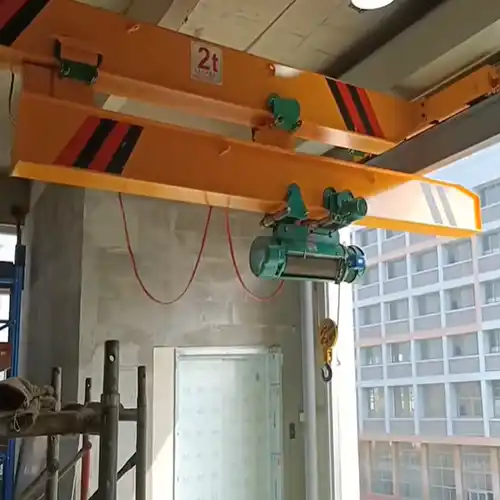
Types of outdoor electric hoists:
Electric Chain Hoists: Versatile and suitable for various lifting applications on construction sites.
Electric Wire Rope Hoists: Ideal for heavier loads and longer lifts.
Typical Outdoor Cranes Equipped:
Gantry Cranes: Provide mobility and stability for lifting and positioning heavy construction materials.
Jib Cranes: Useful for targeted lifting and positioning of equipment and tools in elevated positions.
Typical loads handled:
Steel beams, concrete blocks, construction materials, and equipment.
Functions of outdoor electric hoists:
Lifting and positioning of construction materials.
Assisting in erecting steel structures.
Handling tools and equipment in elevated positions.
Typical Applicable Environment:
Construction sites where heavy materials and equipment need to be lifted and positioned.
Custom features of outdoor electric hoists and cranes:
Weather-resistant and corrosion-resistant materials for durability in outdoor conditions.
Emergency stop functions, overload protection, and limit switches for enhanced safety.
Compact and maneuverable designs for use in confined spaces on construction sites.
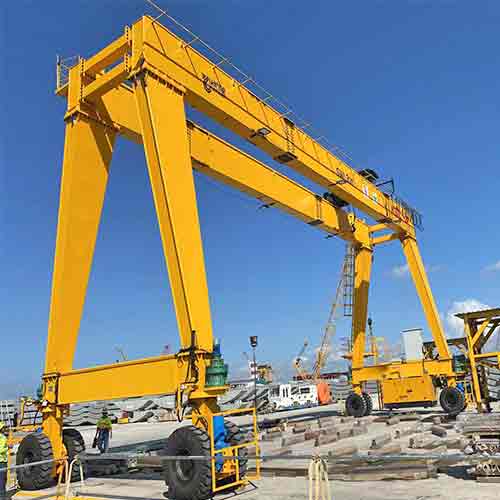
Shipping Yards and Ports:
Types of outdoor electric hoists:
Electric Wire Rope Hoists with Container Spreaders: Designed for efficient handling of shipping containers.
Explosion-Proof Electric Chain Hoists: Suitable for hazardous environments common in port areas.
Typical Outdoor Cranes Equipped:
Container Cranes: Specialized for loading and unloading cargo from ships.
Mobile Harbor Cranes: Provide versatility for moving heavy containers within port yards.
Typical loads handled:
Shipping containers and large cargo items.
Functions of outdoor electric hoists:
Loading and unloading cargo from ships.
Moving heavy containers within port facilities.
Typical Applicable Environment:
Shipping yards, ports, and logistics hubs where large cargo needs to be lifted and transported.
Custom features of outdoor electric hoists and cranes:
Corrosion-resistant materials for durability in marine environments.
Remote control options for precise container handling.
High lifting capacities and speeds to meet the demands of port operations.

Types of outdoor electric hoists:
Explosion-Proof Electric Wire Rope Hoists: Designed for safe operation in potentially explosive mining environments.
Heavy-Duty Electric Chain Hoists: Suitable for lifting and transporting mining equipment.
Typical Outdoor Cranes Equipped:
Overhead Cranes: Provide efficient lifting solutions for heavy mining equipment and materials.
Gantry Cranes: Used for lifting and transporting mining equipment.
Typical loads handled:
Mining equipment, extracted minerals, and materials.
Functions of outdoor electric hoists:
Lifting and transporting mining equipment and materials.
Handling and moving extracted minerals.
Typical Applicable Environment:
Mining sites where heavy equipment and materials need to be lifted and transported.
Custom features of outdoor electric hoists and cranes:
Explosion-proof and rugged construction for safe operation in harsh mining conditions.
Advanced control systems for precise material handling.

Forestry and Logging:
Types of outdoor electric hoists:
Logging Winches: Tailored for hoisting and transporting logs in forestry operations.
Typical Outdoor Cranes Equipped:
Log Grapple Cranes: Equipped with grapples for securely lifting and moving logs.
Typical loads handled:
Logs and timber.
Functions of outdoor electric hoists:
Hoisting and transporting logs.
Assisting in forestry equipment maintenance.
Typical Applicable Environment:
Forestry and logging sites where logs and timber need to be lifted and transported.
Custom features of outdoor electric hoists and cranes:
Durable construction to withstand exposure to outdoor elements.
Specialized attachments for secure handling of logs.

Types of outdoor electric hoists:
Electric Chain Hoists with Load Attachments: Configured for lifting and moving various types of agricultural machinery.
Typical Outdoor Cranes Equipped:
Portable Gantry Cranes: Provide flexibility for handling agricultural equipment in different locations.
Typical loads handled:
Agricultural machinery, tractors, plows, and crops.
Functions of outdoor electric hoists:
Lifting and moving agricultural machinery.
Assisting in handling and transporting crops.
Typical Applicable Environment:
Agricultural settings, farms, and areas where farm equipment needs to be lifted and positioned.
Custom features of outdoor electric hoists and cranes:
Resistant to dust and agricultural debris for reliable operation in farm environments.
Configurations to handle different types of agricultural equipment.
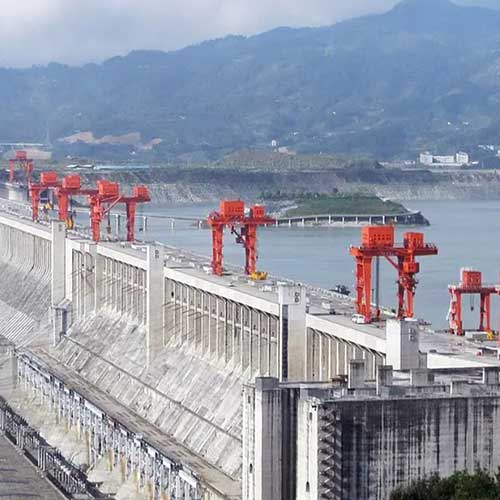
Types of outdoor electric hoists:
Heavy-Duty Electric Wire Rope Hoists: Suitable for handling transformers and heavy power distribution components.
Typical Outdoor Cranes Equipped:
Overhead Cranes: Provide efficient solutions for maintenance of outdoor electrical equipment.
Typical loads handled:
Transformers, power distribution components.
Functions of outdoor electric hoists:
Maintenance of outdoor electrical equipment.
Handling transformers and power distribution components.
Typical Applicable Environment:
Utilities and power plants where outdoor electrical equipment needs to be maintained.
Custom features of outdoor electric hoists and cranes:
Weather-resistant and corrosion-resistant materials for longevity in outdoor settings.
Advanced control systems for precise handling of delicate electrical components.
Typical Loads and Objects:
Heavy Machinery and Equipment:
- Typical loads handled: Generators, compressors, and other industrial machinery.
- Types of outdoor electric hoists: Electric Wire Rope Hoists: Suitable for lifting heavy machinery and equipment, offering higher lifting capacities and speeds.
- Typical Outdoor Cranes Equipped: Gantry Cranes: Provide a stable and mobile solution for lifting heavy machinery in outdoor environments.
- Typical Applicable Environment: Construction sites, manufacturing plants, and other industrial settings where heavy machinery needs to be lifted and positioned outdoors.
Building Materials:
- Typical loads handled: Steel beams, concrete blocks, and construction materials.
- Types of outdoor electric hoists: Electric Chain Hoists: Ideal for lifting and moving construction materials due to their compact and versatile design.
- Typical Outdoor Cranes Equipped: Jib Cranes: Useful for handling building materials in confined spaces or specific locations on construction sites.
- Typical Applicable Environment: Construction sites, building projects, and areas where construction materials need to be lifted and placed.
Containers and Cargo:
- Typical loads handled: Shipping containers and other large cargo items.
- Types of outdoor electric hoists: Electric Wire Rope Hoists with Container Spreaders: Specifically designed for lifting and moving containers efficiently.
- Typical Outdoor Cranes Equipped: Container Cranes: Specialized cranes designed for handling shipping containers in ports and cargo yards.
- Typical Applicable Environment: Ports, shipping yards, and logistics hubs where large containers and cargo need to be lifted and transported.
Logs and Timber:
- Typical loads handled: Timber in forestry and logging operations.
- Types of outdoor electric hoists: Logging Winches: Tailored for the forestry industry, these hoists are designed to handle logs and timber.
- Typical Outdoor Cranes Equipped: Log Grapple Cranes: Equipped with a grapple attachment for securely lifting and moving logs.
- Typical Applicable Environment: Forestry and logging sites where logs and timber need to be lifted and transported.
Mining Equipment:
- Typical loads handled: Drilling rigs, ore, and extracted minerals.
- Types of outdoor electric hoists: Explosion-Proof Electric Wire Rope Hoists: Designed to operate safely in potentially explosive environments, such as mining sites.
- Typical Outdoor Cranes Equipped: Overhead Cranes: Provide efficient lifting solutions for heavy mining equipment and materials.
- Typical Applicable Environment: Mining operations where heavy equipment and minerals need to be lifted and transported.
Agricultural Machinery:
- Typical loads handled: Tractors, plows, and other farming equipment.
- Types of outdoor electric hoists: Electric Chain Hoists with Load Attachments: Configured to securely lift and move various types of agricultural machinery.
- Typical Outdoor Cranes Equipped: Portable Gantry Cranes: Provide flexibility for handling agricultural equipment in different locations.
- Typical Applicable Environment: Agricultural settings, farms, and areas where farm equipment needs to be lifted and positioned.
It's important to note that the specific choice of outdoor electric hoists and cranes may vary based on the unique requirements of each application and the environmental conditions in which they operate.
Selecting the Right Outdoor Electric Hoist
Assessing Specific Outdoor Applications
Different outdoor tasks require distinct functionalities from an electric hoist. Consider these specific applications:
- Construction and Building Sites -For construction purposes, the hoist should withstand heavy loads and harsh conditions. A hoist with high load capacity, durability against weather elements, and precise control mechanisms is vital. Look for features like robust construction, weatherproofing, and ease of mobility if needed for different job sites.
- Landscaping and Material Handling -In landscaping and material handling tasks, versatility and ease of use are key. A hoist that allows for precise lifting and controlled movement while handling landscaping materials or bulky objects is essential. Consider factors like ease of maneuverability, adaptability to different load shapes/sizes, and corrosion-resistant features for longevity.
- Off-Road Recovery and Vehicle Mounting -In off-road recovery or vehicle mounting scenarios, electric winches play a crucial role. Choose a winch with a strong pulling capacity, durable construction, weather-resistant properties, and a reliable braking system. Remote control functionality and ease of installation are also significant considerations.
Comparing Brands and Models
When choosing an outdoor electric hoist, assessing various brands and models is essential to make an informed decision:
- Reviewing Top Manufacturers -Research reputable manufacturers known for their quality and reliability in producing outdoor electric hoists. Look for customer reviews, industry ratings, and expert opinions to gauge the reputation and trustworthiness of different brands. Manufacturers known for their durable, weatherproof, and feature-rich hoists are preferable.
- Evaluating Performance, Warranty, and Support -Compare the performance metrics of different hoists, such as load capacity, speed, and control features. Additionally, consider the warranty offered by the manufacturer and the availability of customer support. A reliable warranty and excellent customer service ensure peace of mind and assistance if issues arise with the hoist.
By considering the specific requirements of your outdoor applications and comparing different brands and models, you can narrow down your options to select the most suitable outdoor electric hoist. In the subsequent sections, we will explore installation guidelines, maintenance practices, and real-world applications to further enhance your understanding and utilization of these powerful lifting tools.
Installation and Maintenance
Installation Guidelines for Outdoor Environments
Installing an outdoor electric hoist correctly ensures its optimal performance and longevity:
Mounting Considerations and Site Preparation
Before installation, carefully choose the mounting location considering factors like structural integrity, accessibility, and load requirements. Ensure the mounting surface can support the hoist's weight and the loads it will handle. Proper anchoring and reinforcement might be necessary for stability.
Additionally, assess the surrounding environment for potential hazards and ensure adequate clearance for safe operation. Pay attention to overhead obstacles, electrical lines, and obstructions that might interfere with the hoist's movement.
Wiring and Power Supply Requirements
Verify the compatibility of the hoist's power requirements with the available power supply in the outdoor environment. Install wiring according to manufacturer guidelines and local electrical codes. Weatherproof the electrical connections and consider protective measures like conduit enclosures to safeguard against moisture and environmental elements.
Ensure a reliable power source to prevent voltage fluctuations or power interruptions that could affect the hoist's performance.
Ongoing Maintenance for Longevity
Regular maintenance is crucial to keep the outdoor electric hoist operating at its best:
Cleaning and Lubrication Practices
Periodically clean the hoist, removing debris, dirt, or any accumulated grime that might hinder its operation. Use appropriate cleaning agents recommended by the manufacturer to prevent damage to the hoist's components.
Lubrication is vital for smooth and efficient operation. Follow the manufacturer's guidelines for lubrication intervals and use recommended lubricants to maintain the hoist's moving parts.
Regular Inspection and Component Replacement
Schedule routine inspections to identify signs of wear, corrosion, or damage. Check for loose bolts, frayed cables, or worn-out components. Address any issues promptly to prevent further damage or potential safety hazards.
Consider a preventive maintenance schedule that includes component replacement when necessary. This might involve replacing worn-out cables, deteriorated seals, or any damaged parts that compromise the hoist's performance or safety.
By adhering to proper installation procedures and implementing a structured maintenance regimen, you can ensure the reliability, safety, and durability of your outdoor electric hoist.
Custom Outdoor Electric Hoists for Sale, Get Informed Purchasing Decision
From their robust construction to their adaptability in challenging environments, these hoists offer a range of benefits:
- Durability and Resilience: Outdoor electric hoists are engineered to withstand harsh weather conditions, ensuring durability and consistent performance in outdoor settings.
- Enhanced Efficiency: Their precision control, varying load capacities, and safety features boost operational efficiency across industries, reducing manual labor and optimizing workflow.
- Versatile Applications: From construction sites to warehouses, landscaping, off-road adventures, and more, these hoists cater to a wide array of outdoor tasks, showcasing their adaptability and utility.
Tips for Making an Informed Purchase Decision
As you embark on selecting an outdoor electric hoist, here are some key tips to ensure an informed purchase:
- Assess Specific Requirements: Evaluate your outdoor application needs thoroughly, considering load capacity, environmental challenges, and specific functionalities required for efficient operations.
- Research Brands and Models: Compare reputable manufacturers, delve into performance metrics, warranty options, and customer support to choose a hoist that aligns with your requirements.
- Prioritize Safety and Maintenance: Opt for hoists with robust safety features and commit to regular maintenance schedules outlined by the manufacturer to prolong the hoist's longevity and ensure safe operation.
- Consider Real-World Feedback: Draw insights from success stories and testimonials from industry professionals to understand the practical impact and effectiveness of different hoists in real-world scenarios.
By prioritizing these considerations and utilizing the insights gained from this guide, you'll be well-equipped to select the most suitable outdoor electric hoist that meets your specific needs, ensuring enhanced efficiency, safety, and longevity in your outdoor operations.
Main Projects
Related Products

Supplied three grab bucket crane kits to Indonesia, enhancing garbage handling efficiency with high load capacity and reliable performance.
Free consultation to Confirm Parameters & Specifications and Get
Latest Crane Price & Crane Rate.
- Types of overhead cranes : _______?
- Optional: Overhead travelling crane, goliath gantry crane,Slewing jib crane, Single girder or double girder crane,small portable crane or kbk crane, etc.
- Capacity of overhead crane: _______?
- Optional: 0.25ton, 0.5 ton, 1 ton, 2 ton, 3ton, 5 ton, 10 ton,15ton, 20ton, 25 ton, 30ton,35ton, up to 550ton, etc.
- Crane span & lifting height : _______?
- Crane travelling length : _____?
- Control of overhead crane:_______?
- Optional: pendant/ remote/cabin control
- Voltage supply of overhead crane:_____?
- Eg,: 380V50/60HZ,3Phase or others,etc.
- Application/usage of crane:_______?
- Eg,: Steel mill, ,injection mold, cement,stone, concrete,granite, general manufacturing, etc.
Just leave a message via the contact form and our hoist and crane engineer will contact you with in 24working hours.
Get In Touch




